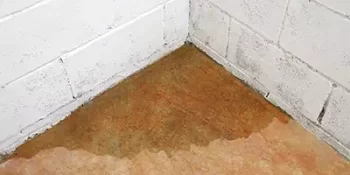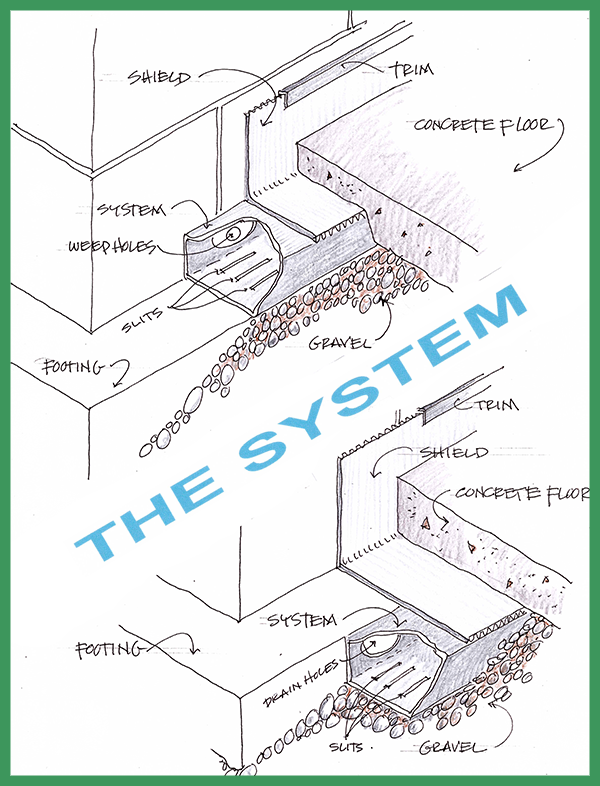Basement Waterproofing
Water damage and moisture issues in basements can be a real headache for homeowners, potentially causing serious damage to their properties. That’s why basement waterproofing is such a crucial step to take. It involves a mix of techniques – sealing up cracks, putting in drainage systems, and applying waterproof coatings to walls and floors – all aimed at making the basement resist water like a champ.
By taking the plunge and waterproofing their basements, homeowners can shield their homes from water damage, keep mold and mildew at bay, breathe easier with improved air quality, and even bump up their property value. It’s a win-win situation all around.
For those looking to get the job done right, the folks at Groundworks have a team of experts who know their way around basement waterproofing. They’re all about keeping homes dry and protected with their reliable, professional services.
Signs of Basement Water Damage
When homeowners spot puddles or standing water in their basement, it often signals a deeper issue that requires attention. The damp air and musty smells don’t just indicate moisture; they hint at possible mold and mildew growth. Foundation cracks and efflorescence on the walls might be early signs of structural damage. Water stains and the unexpected appearance of pests can further complicate matters. Recognizing these signs early is important, but what steps should be taken next to guarantee the basement remains dry and safe?
Puddles and Standing Water
Puddles and standing water in the basement are clear signs of water intrusion that shouldn’t be ignored. These visible indicators often point to underlying issues such as water seepage through foundation cracks or inadequate drainage solutions around the home’s perimeter. If left unchecked, these problems can escalate into more severe basement flooding, leading to costly repairs and potential health hazards.

To address water seepage effectively, homeowners should first identify the source of the intrusion. Common culprits include foundation cracks, poor exterior grading, or malfunctioning gutters. Implementing proper drainage solutions, such as installing French drains or extending downspouts, can help redirect water away from the foundation, minimizing the risk of future flooding.
Another critical step in moisture prevention is the installation of waterproof flooring. This can create a barrier against water and protect the underlying concrete from damage. Additionally, sealing foundation cracks and applying waterproof coatings to walls can further safeguard the basement from water intrusion.
Damp Air and Musty Smells
A basement’s damp air and musty smells often signal excessive moisture and potential mold growth, requiring immediate attention. These conditions not only create an uncomfortable environment but also pose health risks. One effective strategy to combat this is using a dehumidifier. Dehumidifier benefits include reducing moisture levels, which helps in mold prevention. By keeping the air dry, dehumidifiers make the space less welcoming for mold spores.
Ventilation solutions are another key to tackling damp air. Proper ventilation can greatly improve air circulation, reducing humidity levels. Installing vents or exhaust fans can help draw out moist air, replacing it with drier, fresher air from outside. Air purifiers further enhance this process by filtering out airborne mold spores and other contaminants, contributing to overall odor elimination.
To maximize these efforts, combining dehumidifiers with air purifiers can double the impact. This dual approach ensures not only the reduction of moisture but also the purification of the air, making the basement a healthier space. In addition, addressing and sealing any water intrusion points and maintaining proper drainage around the foundation can prevent future moisture buildup, keeping a dry and odor-free environment.
Mold and Mildew
Mold and mildew thrive in basements with high moisture levels, posing significant health risks and damaging property. They can cause serious health hazards, especially for those with allergies or respiratory issues. Mold prevention is essential in maintaining a safe and healthy environment. Regular inspections for dampness and immediate action on any signs of moisture can help prevent mold growth.
To address existing mold and mildew, effective mildew removal methods include using commercial mold cleaners or a mixture of bleach and water. Scrubbing affected areas thoroughly and ensuring they dry completely are essential cleaning techniques. Proper ventilation and dehumidifiers can also reduce moisture levels, further aiding in mold prevention.
The presence of mold and mildew elevates allergy risks, causing symptoms like sneezing, coughing, and skin irritation. In severe cases, mold exposure can lead to more serious respiratory problems. Understanding the importance of keeping the basement dry and tackling mold issues promptly is paramount.
Foundation Cracks
Foundation cracks in the basement can lead to significant water infiltration and structural issues if not addressed promptly. These cracks often serve as entry points for water, which can compromise the basement’s structural integrity. Homeowners should prioritize repairing cracks to prevent leaks and further damage.
Using waterproof sealants is a common method for sealing foundation cracks. These sealants act as a barrier, preventing water from seeping through and causing more extensive issues. However, not all cracks are the same, and some may require more than just a basic sealant application. It’s vital to identify the type and severity of the crack before deciding on the appropriate repair method.
A professional assessment by a structural engineer or a basement waterproofing specialist is often necessary. These experts can inspect the foundation, determine the cause of the cracks, and recommend the best course of action for repairing them. They may suggest more thorough solutions, such as installing interior drainage systems or applying specialized waterproof coatings.
Preventing leaks and maintaining the structural integrity of the basement requires timely and effective action. Ignoring foundation cracks can lead to more serious problems, so addressing them as soon as they’re noticed is essential for safeguarding the home.
Efflorescence
After addressing foundation cracks, homeowners often find efflorescence, a telltale white, powdery substance, on basement walls or floors. Efflorescence in concrete occurs when water passes through masonry, dissolving salts along the way. When the water evaporates, it leaves these salts behind, creating the powdery residue.
Understanding efflorescence causes is key to tackling the problem. Water intrusion, whether from heavy rains, poor drainage, or plumbing leaks, is the primary culprit. To combat this, efflorescence prevention measures should include sealing cracks and ensuring proper drainage around the home.
Efflorescence removal can be done using a stiff brush and a mixture of water and vinegar. However, this is often a temporary fix. For long-term efflorescence treatment, addressing the underlying moisture issue is essential. Waterproofing the basement walls and floors, installing vapor barriers, and improving ventilation can greatly reduce the recurrence of efflorescence.
Ignoring efflorescence can lead to more severe issues like structural damage and mold growth. By being proactive and implementing efflorescence prevention strategies, homeowners can maintain a dry and safe basement environment. Understanding the root causes and treatments guarantees that this common water damage sign doesn’t escalate into a bigger problem.
Water Stains
Water stains in the basement are often the first visible sign of moisture intrusion, indicating potential underlying issues that need immediate attention. These stains can appear as dark discolorations on walls, ceilings, or floors and are clear indicators that water is entering the basement. Addressing water stains promptly can prevent further damage and health risks, such as mold growth.
To tackle water stains, homeowners should first identify the source of the water. Prevention techniques include ensuring proper grading around the home, maintaining gutters, and sealing any foundation cracks. Once the source is addressed, cleaning methods like scrubbing the stained areas with a mixture of water and mild detergent can be used to remove superficial stains. For persistent stains, stronger cleaning agents or professional services might be necessary.
The removal process for water stains isn’t just about aesthetics; it also involves implementing waterproofing options to safeguard the basement. This could include applying waterproof coatings to walls and floors, installing sump pumps, or enhancing drainage systems to prevent future water ingress. Ignoring water stains can lead to more severe issues, underscoring the importance of timely intervention and effective waterproofing solutions.
Pests and Bugs
Basements frequently attract pests and bugs due to their dark and damp conditions, creating an ideal habitat for infestations. Moist environments in basements often harbor spiders, roaches, and silverfish, all of which thrive in these settings. The presence of these pests can be a clear indicator of a moisture problem, emphasizing the importance of moisture control.
Effective pest prevention starts with maintaining basement cleanliness. Regularly cleaning and decluttering the area reduces hiding places and makes the space less appealing to pests. Additionally, employing dampness deterrents, such as dehumidifiers and proper ventilation, helps in keeping the moisture levels in check.
Bug infestation can become a significant issue if not addressed promptly. To mitigate this, homeowners should focus on sealing cracks and gaps in walls and floors, which can serve as entry points for pests. Ensuring proper drainage around the foundation can also prevent water accumulation that attracts bugs.
Main Causes of Water in Basement
Water in basements can be a homeowner’s nightmare, often caused by a variety of factors including groundwater seepage, poor drainage, and high indoor humidity. Groundwater can infiltrate through foundation cracks, while inadequate drainage systems exacerbate the issue by allowing water to pool around the home. High humidity levels inside can lead to condensation, further contributing to the problem. These issues, if left unaddressed, can lead to significant damage and costly repairs. So, what steps can be taken to identify and prevent these common causes of basement water problems?
Identifying Water Issues
How can homeowners spot the early signs of water issues in their basements? Early detection is pivotal in preventing extensive damage. Homeowners should look out for common signs like a saturated base of concrete walls, condensation on walls and floors, or water trickling out of the walls. A persistent mold or mildew odor and stained or blistering walls are also indicators of potential water intrusion.
Potential sources of these issues include groundwater seepage, poor drainage around the foundation, and high indoor humidity from activities such as drying clothes, showering, or cooking. Additionally, poorly ventilated basements can cause condensation, leading to water-related problems.
For effective early troubleshooting, homeowners can perform regular inspections. They should check for cracks in walls or floors and make sure gutters and downspouts are not clogged. It’s also important to observe if any plumbing or appliances are leaking. These steps can help identify issues before they escalate.
Troubleshooting tips to mull over include maintaining proper grading around the house, ensuring downspouts direct water away from the foundation, and keeping an eye on indoor humidity levels. By being vigilant and proactive, homeowners can address water issues early and avoid costly repairs.
Prevention and Solutions
Addressing the root causes of basement water issues involves implementing effective prevention and solutions to protect the home. Proper exterior drainage is essential. Homeowners should regularly check and maintain gutters and downspouts to direct water away from the foundation. Proper grading around the house also helps in preventing water pooling near the base.
Interior waterproofing is another critical measure. Sealing foundation cracks and applying waterproof coatings to walls and floors can prevent water from seeping into the basement. Installing a sump pump ensures any accumulated water is swiftly removed, keeping the basement dry.
Proper ventilation is necessary to reduce moisture and condensation. Using dehumidifiers and ensuring adequate airflow can prevent damp conditions that promote mold growth. Routine inspections for leaks and timely repairs are fundamental in maintaining a dry and healthy basement environment.
Mold prevention is a key aspect of protecting the home. Regularly cleaning and using mold-resistant materials can minimize the risk of mold infestations. Here are some practical steps homeowners can take:
– Maintain exterior drainage: to keep water away from the foundation.
– Seal cracks and waterproof: interior surfaces.
– Ensure proper ventilation: to reduce indoor moisture.
– Regularly clean and inspect: for mold and mildew.
These strategies collectively offer effective solutions to basement water issues.
Waterproofing Solutions for your Basement
Basement Sump Pump
When it comes to kicking standing water out of a basement, a sump pump is the go-to tool. It’s great for tackling ongoing basement water issues or as a smart move to stay ahead of potential problems. For anyone thinking about basement waterproofing, a sump pump should definitely be on their list of must-haves.
Basement Dehumidifier
Even after the sump pump has done its job, pesky moisture, condensation, or small water patches might stick around. That’s where a basement dehumidifier comes in handy, helping to zap that remaining moisture and keep crawl space humidity in check. Teaming up a dehumidifier with other waterproofing tactics is a solid way to keep basements nice and dry.
Interior Drain
If water’s creeping up around the basement edges, an interior drain might be just the ticket. This clever setup creates an opening around the basement perimeter, giving water an easy escape route. Adding a specialized interior drain to the waterproofing mix can really help keep water from crashing the basement party.
Egress Window
Most basements need an egress window as a fire escape – it’s usually required by code. But it’s smart to make sure this window isn’t left out of the waterproofing plan. By working the egress window into the overall waterproofing strategy, homeowners can keep their basements dry while also ticking that important safety box.
The Basement Waterproofing System
- A non-clogging waterproofing system that will accommodate virtually any residential structure.
- It can sit on top of the footing, or in cases of a high footing or the installation of I Beams it can sit beside the footing.
- The System works on water pressure instead of gravity. Water will be forced laterally to a low point-drop pipes in a sump liner.
Why The System will not clog?
- The location on or beside the upper portion of the footing coupled with a significant gravel barrier will enable The System to collect water and not silt, sediment, or mud.
- The System does not work on gravity and cannot lose it’s slope thus trapping unwanted silt, sediment, or mud.
- The System once it’s work is completed will bleed any water or unwanted debris out of the System via the slits underneath, essentially drying out until the next time it is needed.



